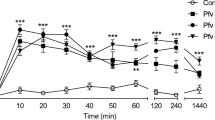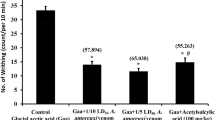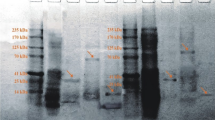Abstract
We compared the edematogenic activity of venoms of scorpions from the Buthidae family, Tityus bahiensis (Tbv), Tityus serrulatus (Tsv) and Rhopalurus rochai (Rrv). Three doses (20, 40 and 80 μg/kg sc) of each venom were administrated in hind paw of mice and edema was measured from 5 min to 24 h. Tbv and Tsv both induced edema of rapid onset (135% of increase at 15 min); Rrv induced only a mild edema (40% of increase). We then investigated the involvement of platelet-activating factor (PAF) and endogenous nitric oxide (NO) in Tbv and Tsv-induced paw edema. Pretreatment of mice with a PAF antagonist (WEB-2170) inhibited Tsv but not Tbv-induced edema. Pretreatment with a non selective inhibitor of NO-synthases (l-NAME) inhibited or increased the edema depending on the dose and the time the edema was measured. In conclusion, the venoms from Tityus are stronger inducers of edema than the venom from the Rhopalurus scorpion. The venoms of Tityus species are similar in potency and time-course edema development. PAF is involved in the edema induced only by Tsv.





Similar content being viewed by others
References
Loret, E., and B. Hammock. 2001. Structure and neurotoxicity of venoms. In: Scorpion biology and research, Brownell, P., and G. Polis eds. Oxford University Press, New York, pp. 204–233.
Amaral, C. F., N. A. Rezende, and L. Freire-Maia. 1993. Acute pulmonary edema after Tityus serrulatus scorpion sting in children. Am J Cardiol. 71(2):242–245. doi:10.1016/0002-9149(93)90746-Y.
Freire-Maia, L. 1995. Peripheral effects of Tityus serrulatus scorpion venom. J Toxicol Toxin Rev. 14:423–435.
Bucaretchi, F., E. C. E. Baracat, R. J. N. Nogueira, A. Chaves, F. A. D. Zambrone, M. R. C. C. Fonseca, and F. S. Tourinho. 1995. A comparative study of severe scorpion envenomation in children caused by Tityus bahiensis and Tityus serrulatus. Rev Inst Med Trop Sao Paulo. 37(4):331–336. doi:10.1590/S0036-46651995000400008.
Freire-Maia, L., and I. M. Matos. 1993. Heparin or a PAF antagonist (BN 52021) prevents the acute pulmonary edema induced by Tityus serrulatus scorpion venom in the rat. Toxicon. 31(9):1207–1210. doi:10.1016/0041-0101(93)90137-8.
Matos, I. M., D. G. Souza, D. G. Seabra, L. Freire-Maia, and M. M. Teixeira. 1999. Effects of tachykinin NK1 or PAF receptor blockade on the lung injury induced by scorpion venom in rats. Eur J Pharmacol. 376(3):293–300. doi:10.1016/S0014-2999(99)00382-9.
Horen, W. P. 1972. Insect and scorpion sting. JAMA. 221(8):894–898. doi:10.1001/jama.221.8.894.
Wilson, J. M. 1987. The scorpion story. Br Med J (Clin Res Ed). 295(6613):1642–1644.
Chen, B., X. Zhuo, C. Wang, and Y. Ji. 2002. Asian scorpion BmK venom induces plasma extravasation and thermal hyperalgesia in the rat. Toxicon. 40(5):527–533. doi:10.1016/S0041-0101(01)00248-3.
Nascimento, E. B. Jr., K. A. Costa, C. M. Bertollo, A. C. P. Oliveira, L. T. S. Rocha, A. L. S. Souza, M. B. A. Glória, T. Moraes-Santos, and M. M. Coelho. 2005. Pharmacological investigation of the nociceptive response and edema induced by venom of the scorpion Tityus serrulatus. Toxicon. 45(5):585–593. doi:10.1016/j.toxicon.2004.12.020.
Montrucchio, G., G. Alloatti, and G. Camussi. 2000. Role of platelet-activating factor in cardiovascular pathophysiology. Physiol Rev. 80(4):1669–1699.
Cirino, G., S. Fiorucci, and W. C. Sessa. 2003. Endothelial nitric oxide synthase: the Cinderella of inflammation. Trends Pharmacol Sci. 24(2):91–95. doi:10.1016/S0165-6147(02)00049-4.
Nishikawa, A. K., C. P. Caricati, M. L. Lima, M. C. dos Santos, T. L. Kipnis, V. R. Eickstedt, I. Knysak, M. H. da Silva, H. G. Higashi, and W. D. da Silva. 1994. Antigenic cross-reactivity among the venoms from several species of Brazilian scorpions. Toxicon. 32(8):989–998. doi:10.1016/0041-0101(94)90377-8.
Becerril, B., M. Corona, F. I. V. Coronas, F. Zamudio, E. S. Calderon-Aranda, P. L. Fletcher, B. M. Martin, and L. D. Possani. 1996. Toxic peptides and genes encoding toxin γ of the brazilian scorpions Tityus bahiensis and Tityus stigmurus. Biochem J. 313(Pt 3):753–760.
He, P., J. Wang, and M. Zeng. 2000. Leukocyte adhesion and microvessel permeability. Am J Physiol Heart Circ Physiol. 278(5):H1686–H1694.
Kwasniewski, F. H., R. G. Landgraf, and S. Jancar. 2008. Small bowel injury associated to allergy is triggered by platelet-activating factor, mast cells, neutrophils and protected by nitric oxide. Int Immunopharmacol. 8(2):371–378. doi:10.1016/j.intimp.2007.10.021.
D’Suze, G., P. Díaz, V. Salazar, C. Sevcik, and J. Brazón. 2007. Effect of leukocyte inhibitors benzydamine and cyclophosphamide, on lung injury caused by Tityus discrepans scorpion venom. Toxicon. 50:1116–1125. doi:10.1016/j.toxicon.2007.07.015.
Coelho, F. M., A. C. Pessini, A. M. Coelho, V. S. Pinho, D. G. Souza, E. C. Arantes, M. M. Teixeira, and A. L. Teixeira. 2007. Platelet activating factor receptors drive CXC chemokine production, neutrophil influx and edema formation in the lungs of mice injected with Tityus serrultatus venom. Toxicon. 50:420–427. doi:10.1016/j.toxicon.2007.04.009.
Petricevich, V. L. 2002. Effect of Tityus serrulatus venom on cytokine production and the activity of murine macrophages. Mediators Inflamm. 11(1):23–31. doi:10.1080/09629350210308.
De-Matos, I. M., A. Talvani, O. O. A. Rocha, L. Freire-Maia, and M. M. Teixeira. 2001. Evidence for a role of mast cells in the lung edema induced by Tityus serrulatus venom in rats. Toxicon. 39(6):863–867. doi:10.1016/S0041-0101(00)00225-7.
Mencia-Huerta, J. M., and J. Benveniste. 1981. Platelet-activating factor (PAF-acether) and macrophages. II. Phagocytosis-associated release of PAF-acether from rat peritoneal macrophages. Cell Immunol. 57(2):281–292. doi:10.1016/0008-8749(81)90087-3.
Mencia-Huerta, J. M., R. A. Lewis, E. Razin, and K. F. Austen. 1983. Antigen-initiated release of platelet-activating factor (PAF-acether) from mouse bone marrow-derived mast cells sensitized with monoclonal IgE. J Immunol. 131(6):2958–2964.
Hogaboam, C. M., D. Donigi-Gale, T. S. Shoupe, E. Y. Bissonnette, A. D. Befus, and J. L. Wallace. 1992. Platelet-activating factor synthesis by peritoneal mast cells and its inhibition by two quinoline-based compounds. Br J Pharmacol. 105(1):87–92.
Petricevich, V. L., and C. F. Peña. 2002. The dynamics of cytokine and nitric oxide secretion in mice injected with Tityus serrulatus scorpion venom. Mediators Inflamm. 11(3):173–180. doi:10.1080/09622935020138811.
Kubes, P., M. Suzuki, and D. N. Granger. 1991. Nitric oxide: an endogenous modulator of leukocyte adhesion. Proc Natl Acad Sci USA. 88(11):4651–4655. doi:10.1073/pnas.88.11.4651.
Wedmore, C., and T. J. Williams. 1981. Control of vascular permeability by polimorphonuclear leukocytes in inflammation. Nature. 289(5799):646–650. doi:10.1038/289646a0.
Kubes, P., M. B. Grisham, J. A. Barrowman, T. Gaginella, and D. N. Granger. 1991. Leukocyte-induced vascular protein leakage in cat mesentery. Am J Physiol Heart Circ Physiol. 261(6 Pt 2):H1872–H1879.
Gaboury, J. P., X. F. Niu, and P. Kubes. 1996. Nitric oxide inhibits numerous features of mast cell–induced inflammation. Circulation. 93(2):318–326.
Kwasniewski, F. H., W. T. Lima, Y. S. Bakhle, and S. Jancar. 2003. Endogenous nitric oxide does not modulate mesenteric mast cell degranulation in rats. Biochem Pharmacol. 65(12):2073–2080. doi:10.1016/S0006-2952(03)00191-6.
Giraldelo, C. M. M., A. Zappellini, M. N. Muscará, I. M. S. de Luca, S. Hyslop, G. Cirino, R. Zatz, G. de Nucci, and E. Antunes. 1994. Effect of arginine analogues on rat hind paw oedema and mast cell activation in vitro. Eur J Pharmacol. 257(1-2):87–93. doi:10.1016/0014-2999(94)90698-X.
Ialenti, A., A. Ianaro, S. Moncada, and M. Di Rosa. 1992. Modulation of acute inflammation by endogenous nitric oxide. Eur J Pharmacol. 211(2):177–182. doi:10.1016/0014-2999(92)90526-A.
Acknowledgements
We thank Fundação de Amparo à Pesquisa do Estado de São Paulo (FAPESP, grant 05/00846-0) and Fundação de Amparo ao Ensino e Pesquisa (FAEP) for their support. The authors also wish to thanks to Dr. Catarina de Fátima Pereira Teixeira and Dr. Rodrigo Álvaro Brandão Lopes Martins.
Author information
Authors and Affiliations
Corresponding author
Rights and permissions
About this article
Cite this article
Severino, D.N., Pereira, R.L., Knysak, I. et al. Edematogenic Activity of Scorpion Venoms from the Buthidae Family and the Role of Platelet-Activating Factor and Nitric Oxide in Paw Edema Induced by Tityus Venoms. Inflammation 32, 57–64 (2009). https://doi.org/10.1007/s10753-008-9102-2
Published:
Issue Date:
DOI: https://doi.org/10.1007/s10753-008-9102-2




